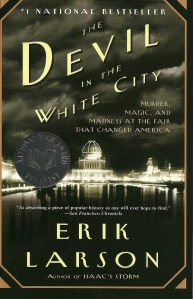The Devil in the White City by Erik Larson ~ A Capsule Review by Allen Kopp
In 1889 France hosted the Paris Exposition, which became the most successful fair of its kind ever held. A few years later, there was to be a fair in America. Chicago was to do the honors. American prestige was on the line. Would Chicago, which some people considered a second-rate city after New York, be able to pull it off?
The Devil in the White City, by Erik Larson, is the story of the 1893 Chicago World’s Fair, which was officially known as the World’s Columbian Exposition to commemorate the four-hundredth anniversary of Columbus’s discovery of the New World.
The Devil in the White City is a fascinating account of the enormous technical and logistical problems facing the planners (chief among them architect Daniel Burnham) of the fair. There were many setbacks (labor unrest, uncooperative weather, conflicting personalities, money shortages, accidents, etc.), but Chicago was able, in a limited amount of time, to put on a fair that was in some ways the defining event of the American Gilded Age. Thousands of laborers, artisans, engineers and architects, working together, transformed a soggy, unattractive, unappealing tract of land on the Chicago lakefront into the fabled White City, which attracted millions of people from all over the world.
There were magnificent buildings, exotic displays, Buffalo Bill’s Wild West show, the world’s first Ferris wheel, lagoons, electric boats, a Wooded Island, and many other attractions. At night the fair was lit with millions of electric lights. Many observers, coming to the fair from farms and small towns, were witnessing the miracle of electricity for the first time. Nobody came away from the fair unmoved. One observer wrote that everything forever after would seem tawdry and insignificant in comparison.
There was, of course, a dark underside to the fair, personified by one Dr. H. H. Holmes, whose real name was Herman Mudgett. He was, arguably, America’s first serial killer. His story is interwoven with the story of the fair. He is the “devil” in The Devil in the White City.
Even if it hadn’t been for the fair, the story of Dr. Holmes would be fascinating. He lived and worked in a Chicago suburb named Englewood, not far from the fair. In appearance and manner, he was the antithesis of a murderer. He was handsome, charming, and dapper. He had a winning way with people that allowed him to manipulate them and get what he wanted from them, which, oftentimes, was to torture and kill them—in some instances to smother them in a vault—or gas them and then burn their bodies so no trace of them would ever be found. Some of his victims are known to have ended up as skeletons in medical schools. He killed an indeterminate number of people, seeking sexual release in murder. He finally confessed to killing twenty-seven, but the number could have been much higher. Many people, possibly hundreds, went to Chicago to visit the fair and were never seen or heard from again. Some of them might have fallen victim to the lethal Dr. Holmes.
The Devil in the White City is, for fans of historical nonfiction, a reading experience not be missed. Even though it’s “history,” it’s never dry or academic or difficult to read. The writing style throughout is accessible and understandable. You may feel at times as though you were reading a novel but, as the saying goes, truth is stranger than fiction. What a movie The Devil in the White City would make! Now, why doesn’t some enterprising filmmaker take on the task of turning this book into a movie? Wouldn’t it be a welcome relief from the tired old recycled crap they keep turning out? I wonder who could play Dr. Holmes?
Copyright © 2011 by Allen Kopp

